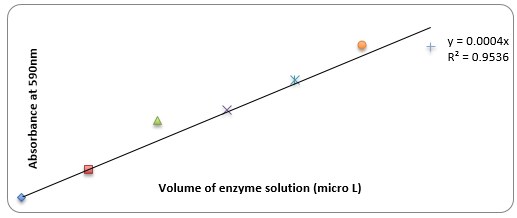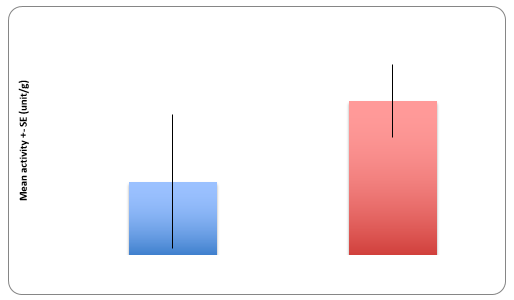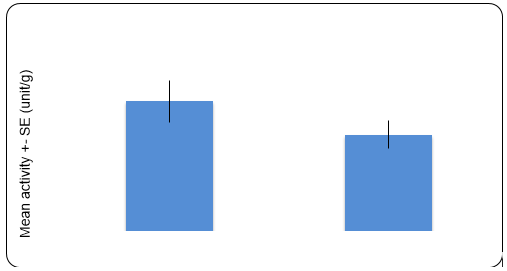AWA: Academic Writing at Auckland
Title: Comparative study into α-amylase activity of two marine gastropods with distinctly different diets
|
Copyright: Dhobasheni Newman
|
Description: A report of the methods and results of a study testing a-amylase activity in two marine gastropod species.
Warning: This paper cannot be copied and used in your own assignment; this is plagiarism. Copied sections will be identified by Turnitin and penalties will apply. Please refer to the University's Academic Integrity resource and policies on Academic Integrity and Copyright.
|
Writing features
|
Comparative study into α-amylase activity of two marine gastropods with distinctly different diets
|
Abstract Spectrophotometry analysis was conducted to comparatively test a-amylase activity in two marine gastropod species, Turbo smaragdus and Cominella adspersa. Statistical tests (f-tests and t-tests) were conducted to test for differences between the a-amylase activity of herbivorous (T. smaragdus) and carnivorous (C. adspersa) marine gastropod. Data was collected and processed as grouped data and individually collected data separately. Statistical analysis showed no differences between the a-amylase activity between species tested (P=0.07 at a=0.05). Difference between individual collected data and grouped data provided a insignificant result between T. smaragdus enzyme activities (P=0.059) and significant difference between C.adspersa enzyme activity (P=0.01). This study provides evidence that there is no difference between the a-amylase activity of herbivorous and carnivorous gastropods but, more study needs to be done in order to understand the significance of food specialisation and ecology in relation to this result.
Introduction Starch is a linear polysaccharide consisting of glucose monomers joined by α-1,4 glucosidic linkages (Campbell et al, 2005). These linear chains are further joined by α 1,6 glucisidic linkages (Stevens et al, 1995 ). Starch is abundant in plant sources and is a cheap source of carbohydrate as it is easily broken down (Omondi, 1996). It is hydrolysed to glucose by amylase, maltases and isomaltase (Stevens et al, 1995). Amylase (α-amylase) is a common almost universal enzyme (Van wheel, 1961) that breaks down starch by hydrolysing the α-1,4 linkages (Stevens et al, 1995). This reaction results in straight chain oligosaccharides and isomaltose as α-1,6 and other linkages can only be hydrolysed by their respective enzymes (Campbell et al, 2005). The following is an experiment conducted to comparatively test amylase activity of two marine gastropods with varying diets and discuss results in relation to their ecology. Turbo smaragdus (Cats Eye), an endemic turbinid gastropod (Alfaro et al, 2007), is found in a wide range of coastal habitats (rocky intertidal and subtidal to estuarine environments) around New Zealand (Morton et al, 1973). They are herbivorous grazers feeding on almost all types of seaweed and algae, only restricted by the availability of food sources (Alfaro et al, 2007). As T. smaragdus are herbivorous it would be expected that they would have a higher capability to hydrolyse starch (greater α-amylase activity) as they encounter mostly starch in their algal based diet. Cominella adspersa (Speckled Whelk) is a Buccinid whelk that is locally abundant in areas on soft bottomed low intertidal and sublittoral zones (Morton et al, 1973). They are exclusively carnivorous but exactly how they feed is debated (Stewart et al, 2004). It is thought they mostly scavenge on already open dead shells or insert a proboscis into the siphonal chink of live bivalves (Morton et al, 1973), otherwise they may use a chip and wedge method (White, 1971). It is however widely accepted that they do not drill to get into their prey (Stewart et al, 2004). As C. adspersa are carnivorous it would be expected that they have a lower capability to lyse starch (low α-amylase activity) as they do not encounter it in their diet. Materials and Methods* The two snails used in this experiment, Turbo smaragdus (herbivore) and Cominella adspersa (carnivore) were opened and their digestive glands dissected out. The glands were weighed and cut down to100mg or as close as possible. The gland pieces were homogenized with a 1mg:1ml ratio of buffer, a pH 7.4 solution of 50mM bis-Tris and 10mM of CaCl2. This was transferred to an epindorf tube and repeated for each animal. Epindof tubes were then centrifuged for 5 mins at 5000rpm. 50μL of homogenate supernatant was added to 3950μL of bis-Tris buffer in a falcon tube. Two supernatant/buffer samples made for each animal. A standard curve was prepared as described in Clements (2008). Tubes (including standard curve) were pre-incubated in a 37 degree Celsius water bath for 2 minutes. 1 ml of AZCL-starch was added to each tube, vortexed and replaced in the water bath for a further 10 minutes. Falcon tubes were centrifuged and absorbance of the supernatants was calculated from a spectrophotometer. *For more in depth explanation of methods please refer to Clements (2008).
Data Analysis Data was entered into excel 2007 to gain the slope equation from the standard curve (Fig. 1) and perform statistical analyses. Standard curve data was plotted onto a scatter graph to reveal the R2 and slope equation later used in calculating the mean α-amylase activity/1g of digestive gland in each animal. Statistical analyses (t-tests) were carried out between species of individually collected results and between grouped and individual data with α=0.05 to statistically test for differences. Some data was removed from the grouped data set on the basis of a poor standard curve, considerable difference between replicate or simply because data was not calculated properly.
Results
Figure 1: Standard curve slope analysis
Figure 2: Comparative graph of individually collected data showing the mean amylase activity of Turbo smaragdus (herbivore) and Cominella adspersa (carnivore). Figure 3: Comparative graph of grouped data showing the mean amylase activity of Turbo smaragdus (herbivore) and Cominella adspersa (carnivore). Table 1: Results of t-test between T. smaragdus and C. adspersa individually collected data.
Table 2: Results of t-test between T. smaragdus and C. adspersa grouped data.
Table 3: Results of t-test between T. smaragdus from grouped and individually collected data.
Table 4: Results of t-test between C. adspersa from Grouped and individually collected data.
Summary of results There were no significant differences between T.smaragdus and C. adspersa in the individually collected (P=0.07) or grouped (P=0.16) data. There was no significant difference between T. smaragdus of the grouped and T. smaragdus of the individually collected data (P=0.59) but there was however a significant difference between C. adspersa of the grouped data and C. adspersa of individually collected data (P=0.01). All t-test analasyes were conducted at α=0.05.
Discussion The results obtained are not what were expected under the hypothesis that the variation in the gastropods diets would entail greater or lesser amylase activity depending on the starch content of their natural diet. Though graphs (Fig. 1 & 2) show visual difference between amylase activity of T. smaragdus and C. adspersa the result of t-tests proved insignificant (Table 1 & 2) implying that there is no difference in the α-amylase activity. This is an unexpected result as C. adspersa, being a carnivore, does not need the enzymes for breaking down starch in its diet. It has been found in other studies that food specialization does not exclude certain enzymes in molluscs and there is no substantial evidence that enzyme activity differs between species (Van Wheel, 1961). Molluscs as a phylum have an impressive array of enzymes for breaking down the components of their diets (Foster et al, 1998). Though they have diverged greatly in feeding and prey capture methods (Van wheel, 1961) filling many niches, it seems that there is not much difference or specialisation in how they process their food (Van Wheel, 1961). Why this is remains largely unknown as there does not appear to be much literature on the gastropod digestive process and evolution. It could be argued that it is this lack of specialisation that has allowed them to invade and hold such an array of niches. Gut content analyses of T. smaragdus conducted by Alfaro et al (2007) revealed that much of their nutrients are obtained from bacteria. The break down of bacteria requires protease and other enzymes not associated with the breakdown of starch (Van Wheel, 1961). This provides further evidence for the lack of diet enzyme specialisation between species. It could be argued that this lack of specialisation in T. smaragdus’ diet is and adaptation to obtaining the most out of their food sources. Many of the plant food sources that they exploit are ideal substrates for bacterial growth (Alfaro et al, 2007) therefore by retaining the ability to process protein as well as starch they are not wasting useful nutrients, which if unprocessed would add greater fibre to their diets making them feed more often than they should really need to. Limitations and analysis of study In the grouped data results much of the data was excluded due to discrepancies in the data leading to potential bias, as many of the data contributions were lost. This reduction in the sample size decreases the robustness of the results and provides a greater source of error. This potential for error however is expected with complex data collection methods such as the ones used to obtain amylase activity. The individual results obtained from this experiment were excluded from the grouped data on the basis of there being a large discrepancy between absorbance of the same animal. Causes of this discrepancy could be due to pipetting, disruption of pellet causing mixing into supernatant or general sampling error (though unlikely as discrepant data was sampled from the same sampled animal). Other results were excluded on the basis of incorrect equation calculation and weak correlation coefficients. Though it is difficult to pinpoint exactly where the error lies, there are several ways in which this potential non-sampling error could be avoided if the experiment were to be repeated. The spectrometers were difficult to read due to the readings changing sporadically (not due to the equipment being faulty, just due to the nature of the machines). Error from recording this data could be reduced by taking more than one reading from each sample. To calculate the final readings more accurately it may help to calculate an overall average standard curve for all the data to be calculated from and all the data should be processed and calculated (or at least checked over) by one or only a few individuals to avoid many human errors. In addition to this study it may be worthwhile to conduct observations of the species of interest in their natural habitat, coupled with a gut analysis. These could then be used to confirm the diets of the animals sampled. Other observational experiments that may prove interesting and reveal more about the digestive capabilities of these creatures could be to fed them set diets of varying levels of starch. Or (ethics and methods permitting) swap the diets, feeding the herbivore a high protein and the carnivore a high starch diet to assess the effectiveness of their enzyme activities. This experiment only looked at the activity of one enzyme, amylase, in two species that have different dietary intakes. The process of starch breakdown involves many enzymes as amylase can only break α-1,4 linkages (Campbell, 2005). It would be interesting to look at the activity of other enzymes and compare them to see if there is any difference between the activity with different concentrations of protein and carbohydrate. It may also be interesting to test a range of gastropod species from different habitats (e.g. marine and terrestrial) comparing their diets. Conclusions There was no significant difference between the a-amylase activity of herbivorous gastropod T. smaragdus and the carnivorous marine gastropod C. adspersa. Though studies show there appears to be no difference between the array of digestive enzymes that species of gastropod possess. More study needs to be done in order to fully understand the significance of food specialisation in relation to the lack of enzyme specialisation and how it applies to the ecology of these organisms.
|
|



